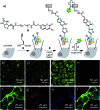Copper-Catalyzed Click Reaction on/in Live Cells
- PMID: 28348729
- PMCID: PMC5365239
- DOI: 10.1039/C6SC02297A
Copper-Catalyzed Click Reaction on/in Live Cells
Abstract
We demonstrated that copper-catalyzed azide-alkyne cycloaddition (CuAAC) reaction could be performed inside live mammalian cells without using a chelating azide. Under optimized conditions, the reaction was performed in human ovary cancer cell line OVCAR5 in which newly synthesized proteins were metabolically modified with homopropargylglycine (HPG). This model system allowed us to estimate the efficiency of the reaction on the cell membranes and in the cytosol using mass spectrometry. We found that the reaction was greatly promoted by a tris(triazolylmethyl)amine CuI ligand tethering a cell-penetrating peptide. Uptake of the ligand, copper, and a biotin-tagged azide in the cells was determined to be 69 ± 2, 163 ± 3 and 1.3 ± 0.1 µM, respectively. After 10 minutes of reaction, the product yields on the membrane and cytosolic proteins were higher than 18% and 0.8%, respectively, while 75% cells remained viable. By reducing the biothiols in the system by scraping or treatment with N-ethylmalemide, the reaction yield on the cytosolic proteins was greatly improved to ~9% and ~14%, respectively, while the yield on the membrane proteins remained unchanged. The results indicate that out of many possibilities, deactivation of the current copper catalysts by biothiols is the major reason for the low yield of CuAAC reaction in the cytosol. Overall, we have improved the efficiency for CuAAC reaction on live cells by 3-fold. Despite the low yielding inside live cells, the products that strongly bind to the intracellular targets can be detected by mass spectrometry. Hence, the in situ CuAAC reaction can be potentially used for screening of cell-specific enzyme inhibitors or biomarkers containing 1,4-substituted 1,2,3-triazoles.
Figures





Similar articles
-
Tripodal Amine Ligands for Accelerating Cu-Catalyzed Azide-Alkyne Cycloaddition: Efficiency and Stability against Oxidation and Dissociation.Catal Sci Technol. 2017;7(12):2474-2485. doi: 10.1039/C7CY00587C. Epub 2017 Apr 26. Catal Sci Technol. 2017. PMID: 29129990 Free PMC article.
-
Comparative analysis of Cu (I)-catalyzed alkyne-azide cycloaddition (CuAAC) and strain-promoted alkyne-azide cycloaddition (SPAAC) in O-GlcNAc proteomics.Electrophoresis. 2016 Jun;37(11):1431-6. doi: 10.1002/elps.201500491. Epub 2016 Mar 1. Electrophoresis. 2016. PMID: 26853435 Free PMC article.
-
Intermediates Stabilized by Tris(triazolylmethyl)amines in the CuAAC Reaction.Chemistry. 2017 Apr 3;23(19):4730-4735. doi: 10.1002/chem.201700555. Epub 2017 Mar 15. Chemistry. 2017. PMID: 28191741
-
In-situ Generated and Premade 1-Copper(I) Alkynes in Cycloadditions.Chem Rec. 2017 Dec;17(12):1231-1248. doi: 10.1002/tcr.201700011. Epub 2017 Jun 22. Chem Rec. 2017. PMID: 28639363 Review.
-
Recent Advances in Recoverable Systems for the Copper-Catalyzed Azide-Alkyne Cycloaddition Reaction (CuAAC).Molecules. 2016 Sep 5;21(9):1174. doi: 10.3390/molecules21091174. Molecules. 2016. PMID: 27607998 Free PMC article. Review.
Cited by
-
Synthetic prodrug design enables biocatalytic activation in mice to elicit tumor growth suppression.Nat Commun. 2022 Jan 10;13(1):39. doi: 10.1038/s41467-021-27804-5. Nat Commun. 2022. PMID: 35013295 Free PMC article.
-
Alkynylated and triazole-linked aroyl-S,N-ketene acetals: one-pot synthesis of solid-state emissive dyes with aggregation-induced enhanced emission characteristics.Sci Rep. 2023 Sep 1;13(1):14399. doi: 10.1038/s41598-023-41146-w. Sci Rep. 2023. PMID: 37658089 Free PMC article.
-
Chemoenzymatic synthesis of heparan sulfate and heparin oligosaccharides and NMR analysis: paving the way to a diverse library for glycobiologists.Chem Sci. 2017 Dec 1;8(12):7932-7940. doi: 10.1039/c7sc03541a. Epub 2017 Sep 21. Chem Sci. 2017. PMID: 29568440 Free PMC article.
-
Designing Bioorthogonal Reactions for Biomedical Applications.Research (Wash D C). 2023 Dec 15;6:0251. doi: 10.34133/research.0251. eCollection 2023. Research (Wash D C). 2023. PMID: 38107023 Free PMC article. Review.
-
Internalization and accumulation of model lignin breakdown products in bacteria and fungi.Biotechnol Biofuels. 2019 Jul 3;12:175. doi: 10.1186/s13068-019-1494-8. eCollection 2019. Biotechnol Biofuels. 2019. PMID: 31303895 Free PMC article.
References
Grants and funding
LinkOut - more resources
Full Text Sources
Other Literature Sources

